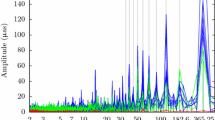Abstract
The Pegasus breakup is characterized by distributions of the orbital parameters and radar cross section of the pieces. The accuracy of the Simplified General Perturbations 4 (SGP4) element sets for the Pegasus breakup has been examined using the Space Surveillance Performance Analysis Tool. A graph of the average error growth rate (EGR) of the Pegasus breakup element sets over time shows pronounced spikes on certain days. Comparing graphs of EGR versus BSTAR (the term in SGP4 that accounts for unmodeled in-track forces, including drag) for all the Pegasus breakup pieces on a day when the average EGR is low and a day when the average is high shows that the element sets with large BSTAR values are susceptible to large variations in EGR. A graph of the average EGR and daily maximum planetary geomagnetic index Ap over times shows that the spikes in EGR are associated with geomagnetic storms. To reduce the size of the spikes in EGR, the length of update interval (LUPI) for the batch differential corrections of the element sets was shortened. To support catalog maintenance of the Pegasus breakup pieces with shorter LUPIs, additional sensors were tasked for observations.
Similar content being viewed by others
References
JOHNSON, N. L. “Monitoring and Controlling Debris in Space,” Scientific American, August 1998, pp. 62–67.
NORAD Technical Publication TP SCC 008, “Mathematical Foundation for SCC Astrodynamic Theory,” Headquarters North American Aerospace Defense Command, Colorado Springs, Colorado, April 1982.
SETTECERRI, T. J., STANSBERY, E. G., OPIELA, J., and MATNEY, M. “Haystack-Pegasus Debris Measurements,” 1997 Space Control Conference, Massachusetts Institute of Technology Lincoln Laboratory, Cambridge, Massachusetts, March 1997.
HEJDUK, M., and TEETS, R. “Space Surveillance Performance Analysis Tool (SSPAT) Prototype Software Documentation,” SenCom Corporation, Colorado Springs, Colorado, January 1997.
Author information
Authors and Affiliations
Rights and permissions
About this article
Cite this article
Miller, J.G. Analysis of the Pegasus Breakup. J of Astronaut Sci 46, 105–118 (1998). https://doi.org/10.1007/BF03546196
Published:
Issue Date:
DOI: https://doi.org/10.1007/BF03546196




